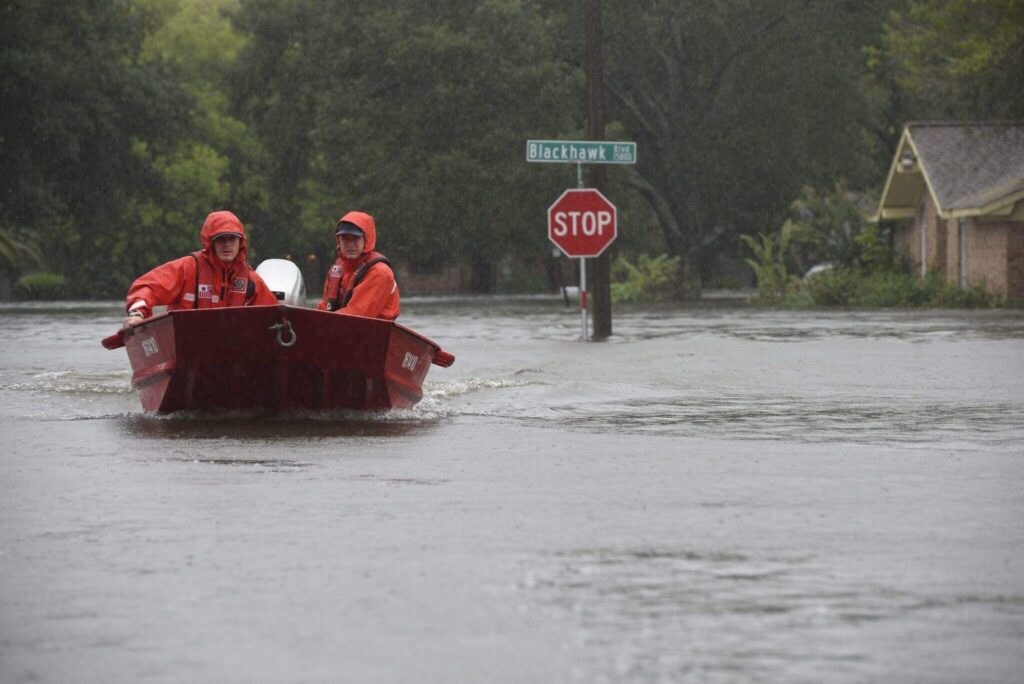August 16, 2022
—
In 2017, Hurricane Harvey exposed the vulnerability of Houston and Harris County. The Category 4 hurricane brought 150 mph winds, overwhelming communities and killing 100 people. Some areas saw over four feet of rain in less than a week — some saw four feet in less than 12 hours.
Five years on, Gulf Coast communities around Houston are still facing the impact of Harvey. Fortunately, local governments also learned from the storm. In this post, we’ll explore the lessons learned for rebuilding Houston and Harris County after Hurricane Harvey, as well as the gaps that still need bridging in coming years.
1. Investing in resilience is smart economics
Harvey highlighted the dramatic need for ongoing, forward-looking investments in resilience. Causing about $125 billion in damage, Hurricane Harvey was the second-most costly hurricane in U.S. history.
To begin addressing these impacts, Harris County voters overwhelmingly passed a $2.5 billion dollar bond in 2018 to go toward flood-protection projects, the topic of one of our previous blog posts. And by November 2020, $74 million had been spent to repair 800 sites damaged by Harvey.

But upfront investments in resilience can also lessen such costs. By one estimate, every $1 invested in resilience saves $6 in potential damages. So, on top of repairing sites damaged by the storm, the city and county also turned to preventing major damages from flooding in the future. Some 200 projects are currently underway.
Though started before Harvey, one flood control project will significantly affect the lives of many Houstonians. Project Brays, which has taken 30 years to build, was finished this year.
Project Brays — Harris County Flood Control’s largest-ever project — widened 21 miles of Brays Bayou, improved 32 bridges, and dug four basins just south of downtown, which can hold 3.5 billion gallons of stormwater in total. The project reduced flood risk for over 15,000 structures in the Brays Bayou Watershed.
2. Championing federal projects is important
But even Harris County Flood Control’s largest-ever project will hold only a fraction of the amount of rainfall felt during Harvey. That’s why other large, ongoing projects are being considered.
At the federal level, one such project is a $31-billion coastal barrier, which is currently under consideration by Congress. Among other things, the barrier would extend an existing seawall and add flood gates to protect the communities around Galveston Bay from storm surge.
Additionally, the Infrastructure Investment and Jobs Act, signed into law in November, provides a great opportunity for communities surrounding Houston, as well as flood-prone communities across the country. Houston can apply for funding for resilient infrastructure projects to prepare for stronger storms and sea level rise, including to prevent stormwater runoff.
But such projects can still take time. Between conducting vulnerability assessments, planning projects, and applying for funds, Houston’s congressional delegation has pushed for many steps to help the region recover and ease the impact of future storms.
For instance, the proposed Hazard Eligibility and Local Projects (HELP) Act, sponsored by Rep. Lizzie Fletcher, an AFC Federal Champion, would help municipalities like Houston and local agencies take steps to accelerate disaster projects, while maintaining eligibility for potential funds from the Federal Emergency Management Agency.
Rep. Dan Crenshaw, AFC’s first Texas Federal Champion, has also been a strong advocate of flood resilience solutions and investments in flood control projects in the Houston area.
3. Resilience should be institutionalized
Though Harvey was significant in size and strength, the Gulf Coast frequently experiences intense tropical storms. As storms become stronger and sea level rises in the future, flood risk will increase for many people living in the area.
To help Houston prepare for and recover from the catastrophic events like hurricanes and floods, as well as slow-moving disasters like aging infrastructure, the city created an Office of Resilience and Sustainability, which includes the position of Chief Resilience and Sustainability Officer. The role and office were merged from two separate offices, in part to better carry out Houston’s resilience strategy, Resilient Houston, which was published in February 2020.
In addition to leveraging “existing and new investment partnerships,” Resilient Houston focuses on Harvey recovery, including ways to modernize Houston’s Construction Code, develop a comprehensive buy-in/buy-out strategy, which are further discussed below.
Also formed after Harvey is AFC member Houston Stronger, which advocates for federal, state, and local funding to support flood resilience around Greater Houston. The coalition focuses on implementing a comprehensive regional flood and storm resilience plan to safeguard our citizens and property.
4. Homes must be rebuilt differently
Harvey damaged tens of thousands homes and displaced thousands of Houston residents for over a year. When rebuilding after Harvey, the city focused on how to improve these homes in the face of future flooding, in some cases buying out homes altogether.
Since Harvey, the city has carried out 27 projects that removed approximately 11,000 homes from the 100-year floodplain and preserved 20,531 acres for projects, floodplain preservation, and buyouts.

The city and county also improved stormwater drainage systems city wide and elevated hundreds of homes. Additionally, the city updated its floodplain regulations to include new standards for construction, including some key changes:
- Expanding where flood-ready standards apply. Before Harvey, Houston’s flood-related construction standards applied to properties within the 100-year floodplain — a floodplain that has a one in 100 chance of seeing a large flood in a given year. Now, the 500-year floodplain is also included, meaning more properties that face flood risk across a larger area are expected to comply.
- Going beyond the mapped floodplain. Harris County now requires that new construction outside of the 500-year floodplain be lifted to a height of one foot above the nearest ground or street surface.
- Elevating new construction. Both Houston and Harris County now require new or significantly renovated buildings to be elevated to two feet above the 500-year flood elevation — previously, new buildings were only required to be one foot above that elevation.
At the local level, Houston City Council Member and AFC member Sallie Alcorn is championing flood solutions, such as rebuilding programs and drainage projects, to keep flood waters out of people’s homes.
5. Flood planning depends on accurate, forward-looking data
During Harvey, many homes outside of FEMA-designated flood zones were damaged. In fact, most homes affected by flooding from Harvey were located outside of the 100-year floodplain.
Part of the problem was how Texas used rainfall data. Prior to Harvey, the state used rainfall data from as far back as 1961, which became the basis for how Texas mapped its floodplains. In 2018, the National Oceanic and Atmospheric Administration released new statewide rainfall estimates, known as Atlas 14, revealing that Texas is already receiving more rainfall than previously estimated.
In other words, Houston infrastructure built to withstand flooding was underestimating the amount of rain expected to fall on the city. No time was that more true than when Harvey made landfall, flooding scores of properties that homeowners thought were safe.
This is all important as sea level rises and storms become stronger. A new NOAA report predicts that roads in Galveston could flood as many as 210 days a year by 2050, up from 17 days projected this year. Community planners and engineers can begin preparing for such floods with projects like elevated roads, pump stations, and other infrastructure — but only if they have accurate, forward-looking data.
In Texas, updated NOAA data from 2018 will help planners moving forward, but since Atlas 14 is only based on historical data, states still need forward-looking modeling. One pending bipartisan proposal, the Providing Research and Estimates of Changes In Precipitation (PRECIP) Act, would direct the federal government to use forward-looking data that projects future conditions based on sea level rise and other factors.
—
The road to recovery from Harvey is long and winding, as Houston and Harris County have shown. But it also holds valuable lessons for other coastal cities, bracing for a future of stronger storms and rising seas.
With the right strategy and long-term approach to these impacts, governments from the city up to the national level can prevent and lessen the impacts of even the strongest storms — and save lives and property in the process. For more on the efforts to create a stronger Houston post-Harvey, visit Harris County Flood Control District’s website and its Chief Resilience and Recovery Officer page.
—
This post was authored by Brandon Pytel, Communications Associate, American Flood Coalition.
Credit for featured image at top: U.S. Coast Guard photo by Petty Officer 3rd Class Corinne Zilnicki/Flickr.






